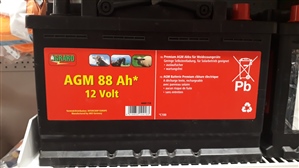Is there any limit to how long a lead acid battery can continuously supply a load, this is assuming that the capacity of the battery is capable of supplying the load for the period of whatever it may be.
That may depend on what sort of load you're talking about.
If it's too high, the battery may melt. A 60Ah battery is unlikely to manage 1000A for 3.6 minutes.
If it's too low, then the self-discharge rate of the battery will be more important. The same 60Ah battery isn't going to supply 10 microamps for 68 years.
Well, maybe it is the self discharge rate that is the limiting factor and will no doubt vary depending on the size of battery.
What I am really asking is a ball park figure for how long a lead acid battery or a bank of batteries can supply a resistive load, is it 1 month, 6 months, 1 year between charges? This is assuming the capacity of the battery and load are matched for the period, I’m asking because I cannot think of an application where a lead acid battery is used for more than a few hours or a day or so at the absolute most.
If you know a lead acid battery will be used to maintain a very small load for a long time, there are changes to the construction that will aid this - internal resistance is less serious than it would be for one required to provide short high level pulses, and so wider electrode spacings and less concentrated acid slow the ageing process, but only to a small extent, perhaps a factor of two. AGM and gell cells are less likely to dry out than a traditional wet cell, and for very lox current applications, drying out is the failure mode.
In the other corner, an engine cranking battery has poor self discharge, but is very low internal resistance. I' expect to check the state and perhaps top up charge every few months if unloaded.
Calcium may be added to the plates in place of the 5-10% antimony that is used to make the lead plates stiff, to make long life batteries, and traces of silver or tin may also be added.
Exact alloys are the battery maker's trade secrets.
You will not get the full thousand cycles of charge and discharge if you only cycle it once a year, and if you only need a few cycles in the full life use, it soon becomes worth looking at other battery chemistry options, and even primary cells instead.
Mike.
/\\ what mapj1 said.
I use a solar trickle charge on a deep cycle 60Ah battery, for remote telemetry systems, these draw 600mA every 5 minutes and 60mA continuous, the solar is 24W (when it's very sunny). Battery volts remains in the range 12V to 12.8V except in the winter when it drops down to 11.5 occasionally.
It is a bit of a side track, but perhaps of interest, reducing the self discharge and decay for things that need to standby for years and then work at high current, there is a dodge where the battery is charged and then drained of electrolyte.
The ‘dry charged’ battery can then be brought back to life in a few minutes by re-admitting the liquid. Battery makes often store them dry and then add the acid just prior to delivery.
The other one, I suspect of even less use is a primary cell where the solid electrolyte battery where the plates are embedded in a block of the electrolyte that is then melted when the battery is needed. This requires a starter fire, so applications are limited. https://en.wikipedia.org/wiki/Molten-salt_battery
Mike
The other thing to watch out for is that lead acid batteries hate being run flat. Deep discharge ones (leisure batteries) can cope better than car batteries, but the usual rule of thumb is that you shouldn't discharge the battery more than 50% if you want to get a decent life from it.
I was in the local agricultural merchants yesterday and they had some interesting battery options for electric fences.
A low self-discharge lead acid battery specified for solar charging.

An alkaline primary battery.

A zinc(?) air battery.

Depending on the load the primary batteries look quite interesting especially if the system can communicate with it’s base station when the battery is getting low.
We're about to take you to the IET registration website. Don't worry though, you'll be sent straight back to the community after completing the registration.
Continue to the IET registration site